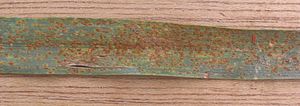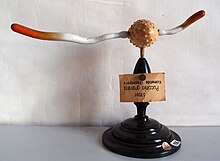Rust fungi
| Rust fungi | ||||||||||||
|---|---|---|---|---|---|---|---|---|---|---|---|---|

Wheat brown rust ( Puccinia recondita f.sp. tritici ) |
||||||||||||
| Systematics | ||||||||||||
|
||||||||||||
| Scientific name | ||||||||||||
| Pucciniales | ||||||||||||
| Clem. & Shear |
The rust fungi or rust fungus-like (Pucciniales, Syn. Uredinales) are an order of the mushrooms (Basidiomycota). They are plant parasites and mainly attack shoot axes and leaves. They have a complex life cycle that often includes a change of host. Several representatives are of economic importance because they attack crops.
Features and ecology
The rust fungi live parasitically in the apoplast , the intercellular space of plant tissues. They do n't kill the tissue in the process. With the help of a haustorium , they penetrate the host cell. They form a mycelium that only rarely affects the entire host plant (such as Uromyces pisi ) and is mostly restricted to the area around the infection site. Buckles are not formed on the dikaryotic hyphae . As sexual organs, they form spermatozoa and conception hyphae, the septal pores are simple and they form distinct minor fruit shapes, all characteristics that they associate with the sac fungi rather than with the mushrooms , to which they belong. The rust fungi do not form any conspicuous fruiting bodies , with only a few exceptions. This is considered to be an adaptation to the way of life on the mostly short-lived herbaceous organs of their host plants.
The rust fungus form a large variety of spores , the full development cycle includes five types of spores. The sequence of the spores is associated with a change of nuclear phase and often also with a change of host. The full cycle can be reduced to different degrees.



A complete cycle occurs in grain rust ( Puccinia graminis ):
- The haploid basidiospores germinate in spring on the leaves of the first host (here barberry ). A parasitic mycelium forms, the cells are mononuclear (haploid). Each of these mycelia forms two different structures: Just below the upper leaf epidermis of the host, they form spermogonia , these form the sex nuclei. They form aecidia on the underside of the leaf . The basal cells formed here take up the genital nuclei and thus form the paired dikaryon. Spermogonia and aecidia are formed on the same mycelium, but self-fertilization is prevented by self-incompatibility: the basidiospores and thus also the mycelia that develop from them are bipolar, there are (+) and (-) hyphae.
- The basal cell can obtain its second nucleus in two ways: After breaking through the plant epidermis, mononuclear spermatia are released from the spermogonium , which transfer their nucleus to a receptive hypha. Preceptive hyphae are hyphae without transverse wall and extend beyond the leaf surface. If a spermatium gets on a conceptual hypha, the cells fuse and the sperm nucleus migrates through the hypha to the basal cell and establishes the couple nucleus stage here. The transmission of the spermatia is promoted by the fact that the spermogonia frequently secrete nectar and are therefore visited by insects, which also transmit the spermatia to other plants. The second way is the transmission of the kernel by somatogamy , which does not occur in grain rust, but in other rusts: here two normal hyphae, one (+) one (-), fuse together. An aecidium forms from the now binuclear basal cell, which breaks through the underside of the leaf and forms dikaryotic aecidiospores in many chains.
- The aecidiospores have a different core phase: they are haploid-dikaryotic. They can only germinate on certain host species, in the case of cereal rust, cereals and other sweet grasses . They form a germ tube that penetrates the host through a gap and grows here intercellularly, but remains locally limited. The mycelium is seeded in pairs, but without buckles.
- This mycelium forms asexual spores in large numbers: conidia , here called uredospores . They are formed in rust-colored beds called uredia that break through the leaf surface. The uredospores are the so-called summer spores and, under suitable conditions, ensure a massive spread of the rust fungus: Millions of spores can be formed on one plant. A haploid-dikaryotic mycelium emerges from the uredospores.
- In autumn , the hibernating forms, the teleutospores, are formed in the uredospore camps or in their own camps, the telia . They are two-celled, have a thick cell wall and are resistant to cold and drought. Nuclear pairing ( karyogamy ) takes place in them , and two diploid cells, the probasidia , arise . In spring they germinate, perform a meiosis and form a tubular basidia : cell walls are drawn in between each of the four nuclei, a basidiospore is formed from each cell, into which the nucleus migrates and is then thrown off. When a basidiospore lands on the correct host, the cycle starts all over again.
meaning
The rust fungi can cause significant economic damage to crops. Grain harvests can be up to 25% lower when infected. The stem rust ( Puccinia graminis ) is spread worldwide, but caused damage in particularly in warmer countries. The yellow rust ( Puccinia striiformis ) is particularly important for wheat in Central Europe. In addition to cereals, a wide variety of crops such as asparagus, carrots, onions are attacked by Puccinia species, peas, beans and beets by Uromyces species. Melampsora lini attacks the common flax . Melampsorella caryophyllacearum causes witch brooms and cancer in silver fir .
Combating the intermediate hosts is usually unsuccessful, as the uredospores can usually also overwinter or attack the winter seeds as early as autumn. Uredospores can also be spread by the wind over very great distances, even across the Alps. Resistance breeding is very difficult because of the large number of physiological breeds in the rust fungus.
Systematics
The sister group of the rust fungi are probably the Platygloeales .
The order consists of 13 families with around 115 genera and 7000 species.
Some genera and species:
-
Cronartium
- Cronartium flaccidum (a cause of the kien's head )
- Straw rust or Weymouth pine bladder rust ( Cronartium ribicola )
-
Endocronartium
- Endocronartium pini (a trigger of the Kienopf )
-
Gymnosporangium
- Pear grate ( Gymnosporangium sabinae )
-
Melampsora
- Linseed grate ( Melampsora lini )
- Rotary pine grate ( Melampsora populnea )
-
Melampsorella
- Pine Cancer ( Melampsorella caryophyllacearum )
-
Puccinia
- Plum rust ( Puccinia discolor )
- Grain rust ( Puccinia graminis )
- Mallow rust ( Puccinia malvacearum )
- Puccinia millegranae
- Puccinia recondita
- Corn rust ( Puccinia sorghi , Syn. P. maydis )
- Yellow rust ( Puccinia striiformis )
- Brown rust of wheat ( Puccinia triticina )
- Nettle rust fungus ( Puccinia urticata )
-
Pucciniastrum
- Spruce cone rust ( Pucciniastrum areolatum )
- Pine needle rust , fuchsia rust ( Pucciniastrum epilobii )
swell
literature
- Andreas Bresinsky, Christian Körner, Joachim W. Kadereit, G. Neuhaus: Strasburger - textbook of botany . 36th edition. Spektrum Akademischer Verlag, Heidelberg 2008, ISBN 978-3-8274-1455-7 , p. 674-678 .
- Dean, Ralph, et al .: The Top 10 fungal pathogens in molecular plant pathology . In: Molecular Plant Pathology . tape 13 , no. 4 , 2012, p. 414-430 , doi : 10.1111 / j.1364-3703.2011.00783.x .
Individual evidence
- ^ Mycobank, accessed October 26, 2012
- ↑ M. Catherine Aime, P. Brandon Matheny, Daniel A. Henk, Elizabeth M. Frieders, R. Henrik Nilsson, Meike Piepenbring, David J. McLaughlin, Les J. Szabo, Dominik Begerow, José Paulo Sampaio, Robert Bauer, Michael Weiß, Franz Oberwinkler, David Hibbett: An overview of the higher level classification of Pucciniomycotina based on combined analyzes of nuclear large and small subunit rDNA sequences . In: Mycologia . tape 98 , no. 6 , 2006, p. 896–905 , doi : 10.3852 / mycologia.98.6.896 ( PDF; 2.54 MB ).
- ^ Robert Bauer, Dominik Begerow, José Paulo Sampaio, Michael Weiß, Franz Oberwinkler: The simple-septate basidiomycetes: a synopsis . Mycological Progress, Volume 5, 2006, pp. 41-66, ISSN 1617-416X , doi: 10.1007 / s11557-006-0502-0 .
Web links
- Dagmar Nierhaus-Wunderwald: rust fungi on spruce trees. (PDF; 264 kB) In: Leaflet for practice. 32nd Federal Research Institute for Forests, Snow and Landscape (WSL), 2000, accessed on July 27, 2012 .
